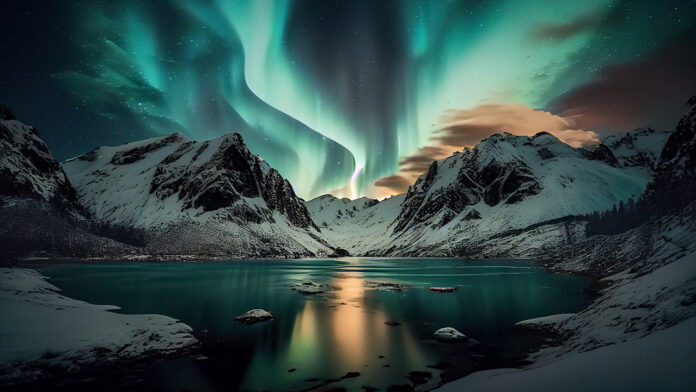The night sky comes alive with a celestial ballet of colors, painting a canvas of wonder that captivates all who witness it—the Aurora Borealis, or Northern Lights. This natural phenomenon, shrouded in mystery and beauty, has intrigued humanity for centuries. In this article, we unravel the enchanting facts surrounding the Aurora Borealis, from the scientific intricacies to the cultural significance that makes it a truly awe-inspiring spectacle.
The Science Behind the Splendor
Solar Wind and Earth’s Magnetic Field: The Aurora Borealis is a result of interactions between charged particles from the Sun, known as solar wind, and the Earth’s magnetic field. As these charged particles collide with atmospheric gases, such as oxygen and nitrogen, they emit light, creating the vibrant hues of the Northern Lights.
Color Variations: The colors of the Aurora Borealis are determined by the type of gas particles and their altitude in the Earth’s atmosphere. Oxygen at higher altitudes produces red and green hues, while nitrogen contributes to purples, pinks, and blues.
Geographic Hotspots for Aurora Viewing
The Arctic Circle: The Arctic Circle is one of the prime locations for witnessing the Aurora Borealis. Countries such as Norway, Sweden, Finland, Iceland, and Canada offer optimal conditions for viewing the Northern Lights during certain times of the year.
Alaska and Northern Canada: In North America, Alaska and northern regions of Canada, particularly Yukon and the Northwest Territories, provide excellent vantage points for experiencing the magic of the Northern Lights.
Cultural Significance
Mythology and Folklore: Across cultures, the Aurora Borealis has been woven into mythology and folklore. In Norse mythology, the lights were believed to be the reflections of the armor of the Valkyries, warrior maidens who chose those worthy of entering Valhalla.
Indigenous Perspectives: Indigenous peoples in the Arctic regions have their own rich interpretations of the Northern Lights. In some cultures, the lights are seen as spirits or ancestors communicating with the living, adding a spiritual dimension to the phenomenon.
Historical Observations
Ancient Chronicles: Historical accounts of the Aurora Borealis date back centuries. Chinese, Greek, and Roman scholars documented observations of the celestial lights, often associating them with divine or supernatural events.
Scientific Exploration: The scientific understanding of the Aurora Borealis has evolved over time. Researchers such as Galileo Galilei and Pierre Gassendi made early contributions to unraveling the mysteries of these celestial lights.
Solar Activity and Aurora Forecasting
Solar Cycles: The intensity and frequency of the Aurora Borealis are closely tied to the solar cycle, an 11-year cycle during which the Sun undergoes periods of increased and decreased solar activity. During periods of high solar activity, the Northern Lights are more likely to be visible.
Aurora Forecast Tools: Today, advancements in technology allow for accurate Aurora Borealis forecasting. Websites and apps provide real-time predictions, helping enthusiasts plan their trips for the best chances of witnessing the spectacular display.
Celestial Phenomena Beyond the Aurora
Aurora Australis: The Southern Hemisphere has its counterpart to the Aurora Borealis—the Aurora Australis or Southern Lights. Similar in nature, this phenomenon occurs near the Antarctic Circle and can be observed from locations in Australia, New Zealand, and southern South America.
Aurora on Other Planets: The interaction of charged particles with planetary magnetic fields is not unique to Earth. Auroras have been observed on other planets in our solar system, providing valuable insights into the atmospheres and magnetic fields of these celestial bodies.
Modern Photography and Aurora Tourism
Photographing the Lights: Advances in camera technology have opened up new possibilities for capturing the beauty of the Aurora Borealis. Long-exposure photography allows enthusiasts to create stunning images that showcase the intricate dance of colors across the night sky.
Aurora Tourism: The allure of the Northern Lights has given rise to a thriving industry of Aurora tourism. Travelers seek out remote and dark-sky locations for a chance to witness the lights in all their glory, contributing to the local economies of these regions.
Astronomical Wonders Accompanying the Aurora
Stargazing Opportunities: Regions with clear skies for Aurora viewing also offer unparalleled opportunities for stargazing. Away from light pollution, observers can witness the beauty of constellations, planets, and other astronomical wonders.
Meteor Showers and Cosmic Events: Some Aurora hotspots coincide with meteor showers and celestial events. The combination of the Northern Lights with shooting stars or other cosmic phenomena creates an extraordinary experience for those fortunate enough to witness it.
Environmental Impact and Conservation
Light Pollution Concerns: The popularity of Aurora tourism raises concerns about light pollution. Artificial lights can interfere with the visibility of the Northern Lights and impact the delicate balance of the natural environment.
Conservation Efforts: Conservation initiatives aim to preserve the pristine dark-sky areas where the Aurora Borealis is best observed. Responsible tourism practices and awareness campaigns play a crucial role in protecting these unique environments.
Conclusion: A Celestial Symphony of Light
In conclusion, the Aurora Borealis stands as a celestial symphony, captivating the hearts and imaginations of those fortunate enough to witness its luminous dance. From the science behind the lights to the cultural significance woven into ancient myths, the Northern Lights continue to inspire awe and wonder. As we navigate the intricacies of solar wind, magnetic fields, and cosmic choreography, the Aurora Borealis remains an enduring testament to the majesty of the night sky—an ever-evolving masterpiece that beckons us to look up, dream, and marvel at the celestial wonders above.

